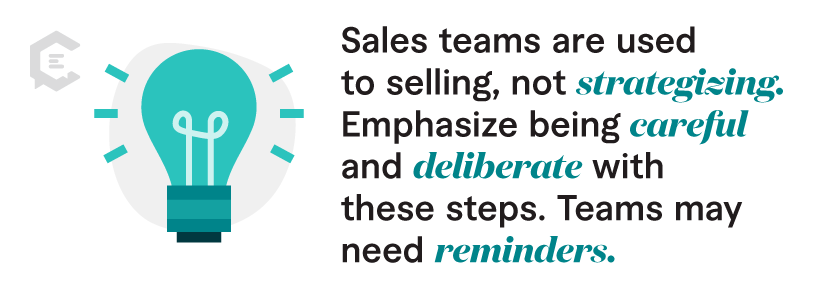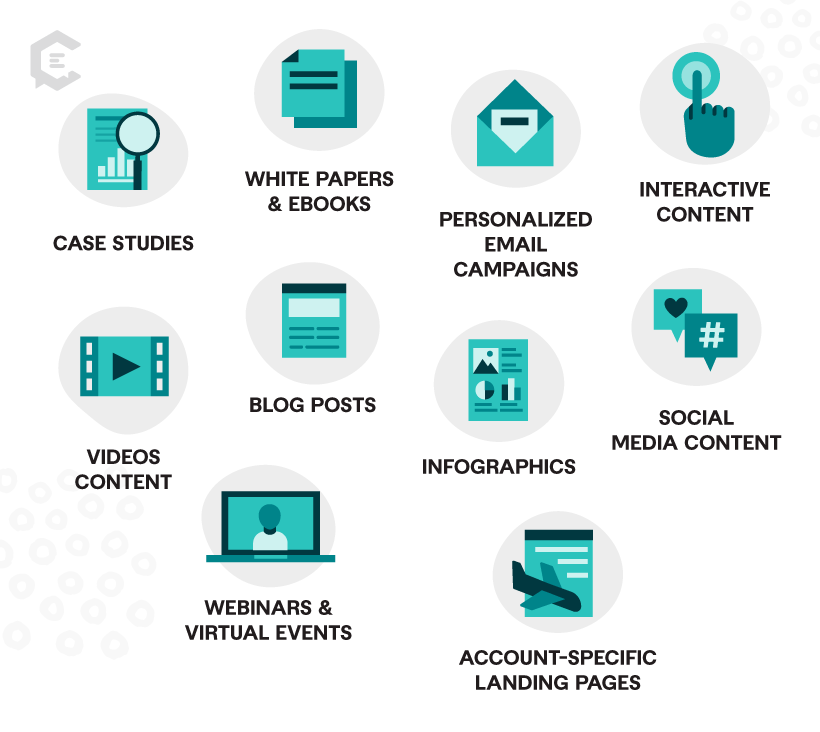Imagine being able to shorten your sales cycle, save time and money, and simultaneously build strong relationships with customers that lead to more business. That might sound like a tall order, but it’s precisely what an account-based marketing (ABM) strategy can achieve.
Gone are the days when you could throw up a blog post and get a bunch of traction. If you want to gain and keep your audience engaged, you must prioritize content personalization.
For B2B businesses, that’s led to an increase in account-based marketing, also known as ABM. With a specific ABM strategy comes specific content creation. In this article, we’ll do an in-depth breakdown of content creation in ABM. We’ll cover the top content types, the best tools and tips, and how to implement your content into your ABM strategy.

First: A Quick ABM Primer
Account-based marketing is much more focused than traditional B2B marketing.
Instead of reaching out to a broad market of businesses, you’re targeting specific companies and their accounts. Then, you’re tailoring your marketing efforts to meet their unique needs and interests.
Think of it like fishing for quality over quantity. In traditional marketing, you’re trying to catch as many fish as possible. You cast a wide net, hoping to capture whatever fish come your way. In this case, the wide net means more general messaging that aims to appeal to a wider audience.
In ABM, you’re after a specific type of “fish.” You research to learn exactly where they swim, what they like to eat, and when they’re the most active. Then, you use the right bait to capture them. That bait is highly personalized content that focuses on your target accounts’ unique needs and characteristics, giving you a higher likelihood to convert.
Before You Start Your ABM Content Creation
All of this may sound well and good, but what does it look like to get started? The following steps may vary, and you could have more or less. The beauty of account-based marketing is that it is truly customizable. If a step doesn’t work for you, that’s OK.
A word of caution. If you’re committed to making an ABM strategy happen, you’ll need to spend considerable time with the prep work. Don’t rush the process. And if you don’t have a content marketing strategy in place, consider building one. Content marketing is a great catalyst for ABM’s success and overcoming potential hurdles.
A special note: sales teams are used to selling, not strategizing. Emphasize being careful and deliberate with these steps. Teams may need reminders.
Building an ABM Content Creation Strategy
1. Bring teams together
Getting salespeople to spend their time on marketing strategy or getting marketing people to accept feedback from sales may not always go as planned. Getting everyone on board is key, and the company’s culture plays a big role in how long this initial step takes.
2. Research the market, customer, and needs
Depending on how much research you’ve done in the past and how recent that data is, this step could take the longest. You will want to look at the market and what it will be. What’s been effective? What could change?
3. Vet the target market, adjust, and identify who you will be selling to
Do you think you know the ideal customer? Think again. You’ll want to look at actual companies using services like yours and see what they spend and what it takes to keep their business.
4. Create the account plan
You know who you’re selling to and why they’re an ideal client. Now comes the plan for creating content that will capture their attention. That includes thinking about what type of new content you’ll create and what existing content you already have that can simply be tweaked or updated.
5. Assign point people
When going from a model where sales and marketing work independently to a plan where they share more legwork, missteps are likely to occur. Laying out clearly who is responsible for research, for example, makes it easier to set expectations and follow up with the same contact when adjustments to the plan need to be made.
6. Attract the right client
Now, it’s time to send that message out into the world. With each sales or marketing person assigned their tasks, you can work on the marketing plan with certainty and focus only on those accounts that have been vetted and set up for success.
7. Measure and optimize
Digital marketing creates data (and lots of it.) What are you doing with all of that information? Hopefully, you’ll use what you’re learning from campaigns to make your efforts more efficient and fruitful. It’s a living, breathing, ongoing process that can — and will — change as needed.
Content Creation in ABM
Once that’s all in place, you can create your ABM content. If you don’t have the time and resources to start from scratch, rework existing content with the new messaging you’ve developed.
Some things to add to your content to make it more personalized:
- Terminology that your prospects understand
- Relevant industry examples
- Case studies from the same industry
- Relevant storytelling
With ABM, you have to think about your sales funnels differently. You’re working on scoring the accounts first.
You create personalized content to engage prospects, and then you build up those relationships. Consider the account overall but also specific members of the team that are making the buying decisions. If there are stakeholders involved, think about them too. Dig deep.
And don’t forget storytelling.
Storytelling is a crucial component of any marketing strategy. Take those fears and challenges that you learned about in your research. Then, weave in stories to help your prospects see how your products and services can help make their lives better. Cast the vision so your target accounts see you are the solution they need.
Also, brainstorm with your team about the types of content you will use. What will be most effective? And if you’re not sure, don’t worry! Guess what the next section is?
The Best Content Types for ABM
- Case Studies: Case studies are powerful for ABM because they provide tangible proof of your value proposition, showcasing how your product or service has successfully addressed challenges similar to those faced by your target accounts.
- White papers and eBooks: White papers and eBooks demonstrate your thought leadership and expertise in your field. Those in-depth insights can build trust and credibility with the decision-makers on your targeted accounts.
- Personalized Email Campaigns: Personalized emails allow for direct and tailored communication with key stakeholders in target accounts, making them feel uniquely understood by addressing their specific needs and pain points.
- Interactive Content: Interactive content like quizzes, assessments, or calculators encourages quick and deep engagement with prospects. They can also help you gain more data on the accounts you’re targeting through their input.
- Video Content: Explainer videos, testimonials, or product demos can convey complex information or demonstrate product value in an eye-catching and engaging way. Plus, they’re easy to consume.
- Blog Posts: Blog posts that address specific trends, issues, or pain points relevant to your target accounts can position your brand as a knowledgeable resource and drive engagement.
- Infographics: Infographics have a dual benefit. They make complex information easy to digest and visually appealing, making them an ideal format to capture a busy professional’s attention.
- Social Media Content: Social media content is great for direct engagement in a more conversational manner. You can use LinkedIn posts, tweets, or Instagram stories to resonate with the specific interests of your target accounts.
- Webinars and Virtual Events: Hosting webinars or virtual events can effectively engage multiple stakeholders simultaneously with direct interaction.
- Account-Specific Landing Pages: Landing pages can be tailored to each target account. Each can address a specific account’s needs and interests while offering relevant content or solutions.
ABM Content Strategies and Tips
Every step of your Account-based marketing strategy may not be obvious initially. Be patient. A high-quality ABM strategy takes talent, time, and continued refinement. In addition to everything we’ve covered above, keep in mind these tips:
Use their language
Future clients respond well when they feel they are heard, and one way to demonstrate you’re listening is by mirroring their language. Avoid stuffing blog posts or case studies with unnecessary jargon, and instead, ask sales teams what they’re hearing when they’re out in the field. Simply restating a common complaint in the way they would make it and then answering how you would solve it can be effective. It displays empathy, industry knowledge, and a much-needed proactive approach toward getting the sale.
Start slow
Decision-makers are busy these days and don’t have time to read pages of text-heavy materials upon their first interaction. Keep marketing assets breezy with summaries, infographics, and digestible blog posts. Then, when they’ve shown interest, hit them with the more detailed marketing assets that show you know the details of the business.
Personalize, personalize, personalize
Remember, ABM is personal. Marketing assets should be created for the individual client, even if it’s updating the name on the marketing content to “XYZ company” from “ABC Corp.” Emails, brochures, and outbound materials should address the prospect by name. Inbound assets, like custom branded web pages or microsites, should speak to specific types of companies within specific industries. The prospect should feel that the site was created just for them — even if it never mentions them by name.
Outsource
Your marketing team may already be at full capacity. If creating your ABM content stretches them too thin, consider teaming up with an experienced content agency well-versed in ABM best practices. They already have existing processes in place to quickly create those unique assets. And they can give you strategic guidance if you need it.
Get Started With Your ABM Content Creation
If you’re finding your ABM challenging, unsure where to begin, or just looking for some extra help, ClearVoice has your back.
Our expert content strategists and creators can help you produce high-quality ABM content. Talk to one of our specialists today to see how we can elevate your strategy, ensure your messaging resonates with your high-value accounts, and drive the results you’re aiming for.






